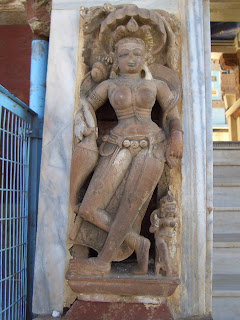Varanasi
Shopping in Varanasi : the silk city !
Silk weaving is perhaps the most popular art of Varanasi.
The shopping hotspots in Varanasi are Chowk, Gyan Vapi, Vishwanath Gali, Thatheri Bazar, Lahurabir, Godoulia or Dashswamedh Gali and Golghar. Besides the illustrious and fine silks and brocaded fabrics, one can also buy shawls, carpets, wall hangings...
When you enter a silk shop, the owner will offer you a masala tea and then he will show you all the silk scarfs he has in his shop ! All of them are very colourful, you can't even choose one because there are so many different styles, colours, sizes... It's like the 1001 nights or Alibaba palace. Completely amazing !

Ganges baths

Very early in the morning, at about six o'clock, hindu people take their bath in the
 Ganges river to purify themselves.
Ganges river to purify themselves.It will purify the soul from sins and is an important step on the way to an ultimate goal - the Nirvana, which means the salvation from the cycle of birth, death and rebirth and ultimately to be one with the almighty God, the creator.
Varanasi also is a favorite place to die, for hindus believe, that one who dies at Varanasi gains emancipation automatically, such is the greatness of this shrine! That's why there are ritual cremations on pyres from Sandle wood and in crematoria each night. All hindus desire, that no matter where they die, at least their ashes be merged in the pious waters of mother Ganga who in Hindu's belief in her immense love for her children will bring emancipation from the trauma of the cycle of birth and death!

The PUJA

 Every evenings, Hindu people perform the "Puja" with lighted lamps.
Every evenings, Hindu people perform the "Puja" with lighted lamps.They offer candles to the Ganges while musicians are playing music and siging holy words.
The ambience is spectacular and very spirituous.






















